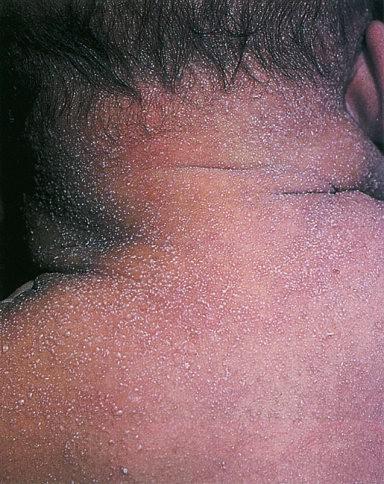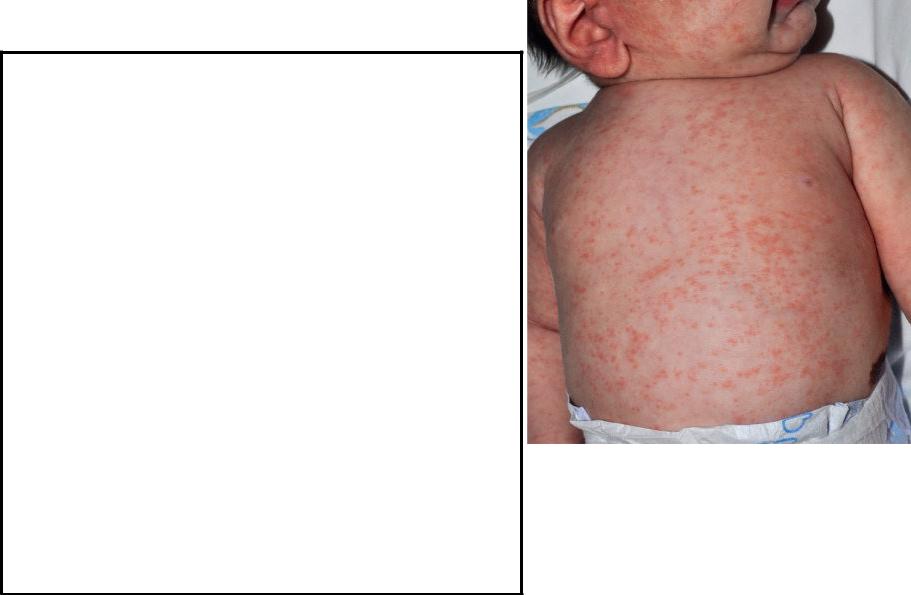
- •NEONATAL DERMATOSIS
- •OUTLINE
- •SKIN FUNCTION IN THE NEONATE
- •ECCRINE SWEATING
- •SEBACEOUS GLAND SECRETION
- •PREVELANCE OF NEONATAL DERMATOSIS
- ••Cutaneous manifestations were observed in 90.5% of the newborns.
- ••With respect to mode of delivery, Vaginally delivered neonates showed significant association with
- •TRANSIENT PHYSIOLOGICAL CHANGES
- •VERNIX CASEOSA
- ••Golden yellow staining - Haemolytic disease of the newborn and postmaturity.
- •FUNCTIONS
- •PERIPHERAL CYANOSIS/ ACROCYANOSIS
- ••The cyanotic hue disappears on warming the extremities.
- •HARLEQUIN COLOUR CHANGE
- ••Wide variation in the duration of attacks, but generally between 30 seconds- 20
- ••As skin matures, this vascular phenomena disappears.
- •CUTIS MARMORATA
- •MONGOLIAN SPOT
- ••Cause-arrested embryonal migration of melanocytes from neural crest to epidermis resulting in dermal
- ••Lesions also occur on the buttocks, dorsal trunk and extremities.
- •SEBACEOUS GLAND HYPERPLASIA
- •SEBACEOUS GLAND HYPERPLASIA
- •MILIA
- •MILIA
- •PALATE-EPSTEIN’S PEARL
- •DESQUAMATION (PHYSIOLOGICAL SCALING OF
- •MACULAR HEMANGIOMA
- •MINIATURE PUBERTY
- ••Scrotal hyperpigmentation and labial hypertrophy-most common findings in miniature puberty .
- ••Enlargement of breast tissue with thick milk-like secretion (witch’s milk) may be seen.
- •SUCKING BLISTERS
- •NEONATAL OCCIPITAL ALOPECIA
- ••The roots in the occipital area do not enter telogen until term, therefore
- •NEONATAL ACNE/ NEONATAL CEPHALIC
- •No additional treatment is needed -usually resolves spontaneously within four months without scarring.
- •LANUGO
- •ANETODERMA OF PREMATURITY
- ••It is non progressive and persistent.
- •SKIN DISORDERS IN THE NEONATE
- •ERYTHEMA TOXICUM NEONATORUM
- ••Commonly seen-term infants, rare in preterm and low birth weight infants.
- ••Could be an innate immune response of a newborn infant to commensal microbes
- •Diagnosis :
- •TRANSIENT NEONATAL PUSTULAR MELANOSIS
- ••It is transient, benign, self-limiting dermatoses of unknown aetiology characterised by 3 types
- •One hour after birth, flaccid vesiculopustules and superficial erosions with minimal surrounding erythema
- •MILIARIA
- ••Miliaria rubra and miliaria crystallina-common in neonates.
- •MILIARIA CRYSTALLINA
- ••Delicate and generally rupture within 24 hr, and are followed by bran-like desquamation.
- •MILIARIA RUBRA (‘PRICKLY HEAT’)
- ••Lesions occur in -flexural areas, especially around the neck and in the groins
- ••Frequently, some lesions are pustular (miliaria pustulosa), but this does not necessarily indicate
- •Management
- •DIAPER DERMATITIS (NAPKIN DERMATITIS OR
- •Three common types of diaper dermatitis are are -
- •Treatment :
- •APLASIA CUTIS CONGENITA
- ••Aplasia cutis congenita may be associated with under lying embryologic malformations like
- •BACTERIAL INFECTIONS
- ••Common skin problems seen in neonates in India.
- •IMPETIGO
- ••Varnish coloured crust is seen.
- •When bullae spread, rupture, and involve large areas, infection may spread systemically, causing
- •DIAGNOSIS :
- •STAPHYLOCOCCAL SCALDED SKIN SYNDROME(SSSS)
- ••The site of blister cleavage is the granular layer.
- ••The first sign of the disease - faint, macular, orange red, scarlatiniform eruption
- •TREATMENT :
- •OMPHALITIS
- •ECTHYMA GANGRENOSUM
- ••Predisposing factors- prematurity, renal failure, neutropenia and immunodeficiencies, necrotizing enterocolitis and bowel surgery.
- •VIRAL INFECTIONS
- •NEONATAL HERPES SIMPLEX
- ••The skin lesions appear between days 2 and 20.
- ••During an intrauterine infection, vesicles appear within 1 day of life.
- •Neonatal herpes simplex showing congenital ulceration and scarring at 10 days.
- •DIAGNOSIS
- •FETAL VARICELLA SYNDROME
- •Pregnant women who are not immune (on the basis of history, and, preferably,
- •FUNGAL INFECTIONS
- •NEONATAL CANDIDIASIS
- ••White, “flaky,” creamy patches are seen on the tongue and mucous membranes of
- ••In the surrounding normal skin there may be punctate erythematous lesions, sometimes pustular
- •CONGENITAL CANDIDIASIS
- ••Palmar and plantar pustules are regarded as a hallmark of congenital cutaneous candidiasis
- •Congenital candidiasis in a neonate born at 24 weeks’ gestation. Note the “burn-like”
- •DISORDERS CAUSED BY TRANSPLACENTAL
- •NEONATAL PEMPHIGUS VULGARIS
- ••No treatment is required as the lesions have resolved spontaneously within about 3
- •NEONATAL LUPUS ERYTHEMATOSUS
- ••It occurs in neonates up to 3 months old.
- ••A ‘spectacle like’ distribution of lesions around the eyes is especially characteristic.
- •Pathology
- ••Infants generally show little sign of residual disease after the age of 1
- •GENODERMATOSIS
- •SOURCE-IADVL
- •MISCELLANEOUS DISORDERS
- •COLLODION BABY
- ••Almost 90% of collodion babies will go on to develop a severe form
- ••Within hours, this membrane
- •MANAGEMENT
- •REFERENCES

MILIARIA
•Disorder due to blockage of eccrine sweat ducts .
•Subdivided into three subtypes dependent on the level of blockage:
-Miliaria crystallina (stratum corneum),
-Miliaria rubra (deeper within the spinous layer)
-Miliaria profunda (dermal–epidermal junction)
54

•Miliaria rubra and miliaria crystallina-common in neonates.
•Predisposing factors : Immature sweat ducts are an important factor in neonates.
•Environmental factors : Heat, humidity, occlusive clothes and plastic sheets.
55

MILIARIA CRYSTALLINA
•CAUSE- obstruction of the eccrine sweat duct as it courses through the stratum corneum.
•Sweat collects beneath the stratum corneum, causing clear, small, flaccid vesicles
•Often likened to “dew drops” & presents as crops of clear, thin walled, superficial vesicles 1–2 mm in
diameter, without associated erythema. |
56 |
|

•Delicate and generally rupture within 24 hr, and are followed by bran-like desquamation.
•Lesions are asymptomatic.
•They arise most frequently during the first 2 weeks of life
•Likely to be seen on the forehead, scalp, neck and upper trunk.
The tiny, superficial vesicles on the back and neck of newborn .
57

MILIARIA RUBRA (‘PRICKLY HEAT’)
•Usually seen after the first week of life
•Also caused by a blockage of the sweat ducts, but
deeper within the spinous layer.
•Obstructed flow leads to leakage of fluid into the lower epidermis and upper dermis, resulting in an inflammatory response producing small erythematous papules, papulo-vesicles, and pustules.
58

•Lesions occur in -flexural areas, especially around the neck and in the groins and axillae.
•Lesions can be itchy or sore.
•Each crop of lesions will subside within 2–3 days, but recurrences are common unless the provocative environmental conditions are
modified.
59

•Frequently, some lesions are pustular (miliaria pustulosa), but this does not necessarily indicate secondary infection.
MILIARIA PUSTULOSA
60

Management
•Milaria crystallina spontaneously improves without therapy over a few weeks as the sweat ducts mature.
•Miliaria rubra will improve in a few weeks without medical treatment if the child is removed from conditions of high heat/humidity and any occlusive clothing or bedding is removed.
•Topically, a soothing agent like calamine lotion is useful. Antibiotics may be needed
61

DIAPER DERMATITIS (NAPKIN DERMATITIS OR
NAPPY RASH)
•Diaper dermatitis-one of the most common skin problems in the newborn.
•Term “diaper dermatitis” mean any skin disease in the diaper area.
•Neonatal skin is irritated with contact from urine, feces, and occlusive condition.
62

Three common types of diaper dermatitis are are -
1)Frictional dermatitis : friction with skin and fabric leads to a breach in stratum corneum, sp. Over perineal area, buttock, and waistlines.
2)Irritant contact dermatitis : due to contact with proteolytic enzyme in stool ,chemical like soap, detergents. It involves convex surface of buttock, vulva, perineal area, lower abdomen, and proximal thigh sparing intertriginous area.
3)Diaper candidiasis
63
